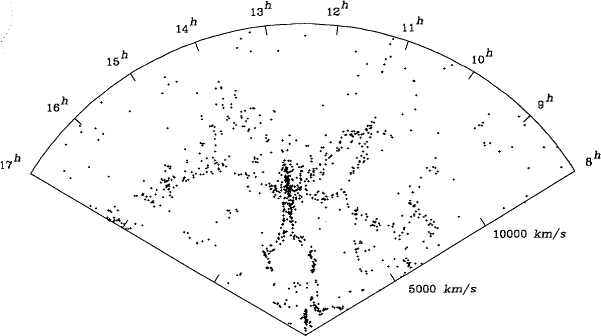![]() Back to
ASTR 3740 Problem Sets
Back to
ASTR 3740 Problem Sets
The mathematical symbols on this page may not print properly on your printer. If you want a printed copy, download the gzip'd PostScript version of this problem set.
1. Wm from the Coma Cluster
 This is
the famous ``Slice of the Universe'' picture
(de Lapparent, Geller & Huchra 1986, ApJ Letters 302, L1).
It is a redshift map of galaxies brighter than apparent magnitude 15.5
in a slice 6° thick passing through the north galactic pole.
The Milky Way is at the vertex of the wedge.
The prominent `finger of god' at 13 hours Right Ascension centered about
7,000 km/s away is the Coma cluster.
This is
the famous ``Slice of the Universe'' picture
(de Lapparent, Geller & Huchra 1986, ApJ Letters 302, L1).
It is a redshift map of galaxies brighter than apparent magnitude 15.5
in a slice 6° thick passing through the north galactic pole.
The Milky Way is at the vertex of the wedge.
The prominent `finger of god' at 13 hours Right Ascension centered about
7,000 km/s away is the Coma cluster.
Clicking on the picture will give you a PostScript version of it;
but be warned, the resolution is lower than the image handed out in class.
You will be better off using the image handed out,
or else photocopying it from the Astrophysical Journal.
(a) Velocity dispersion, radius
From the diagram measure approximately (i) the velocity dispersion v of the Coma cluster in km/s, (ii) the radius (not distance!) H0 r of the Coma cluster in km/s, and hence determine (iii) the ratio v / ( H0 r ). Explain what you did. [Hint: The velocity dispersion is the root mean square orbital velocity of galaxies in Coma, relative to the center of Coma. You can estimate the velocity dispersion from the length of the finger-of-god. You can estimate the radius from the transverse size of the finger-of-god. Question: How far out should I measure? Answer: We are interested in the collapsed part of the Coma cluster, so that we can apply the virial theorem. Clearly the inner parts of the Coma cluster have a higher velocity dispersion than the outer parts, so your answer depends on where exactly you choose to do your measurement. However, it turns out that the final answer we are looking for, Wm in part (d), is (or should be) insensitive to where you choose to cut the cluster, as long as you are consistent all the way through.]
(b) Density of Coma relative to the mean mass density
(i) Estimate the number density nComa, in galaxies (km/s)-3, of galaxies in the Coma cluster
| (1.1) |
| (1.2) |
(c) Density of Coma relative to the critical density
The velocity dispersion v of Coma is related to its mass M and radius r by (this is the virial theorem)
| (1.3) |
| (1.4) |
| (1.5) |
(d) Omega in matter
Assume that mass densities are in proportion to galaxy number densities, rComa / r = nComa / n. Use your results from parts (a)-(c) to infer Wm from the defining formula
| (1.6) |
2. Relation between Horizon and Flatness Problems
Show that Friedmann's equation can be written in the form (compare Problem Set 5, Question 3a)
| (2.1) |